Physico-chemical and inorganic contaminants examination in food grains for high yield and yield stability
Ishrat Alim1 * , Mohammad Rafi2 and Azra Aijaz3
1
ICFAI Institute of Science and Technology,
Hyderabad,
India
2
M.H. College of Home Science and Science for Women,
Jabalpur,
India
DOI: http://dx.doi.org/10.12944/CWE.5.1.10
Food grain quality components like visual quality, nutritional quality, including digestibility and big-availability of nutrients, anti-nutritional factors, milling characteristics, cooking quality, consumer acceptability, and storage stability deserves an important place in evaluation of new varieties as high yield and yield stability. Grain produced in a farmer’s field passes through several transformations before it is consumed in the form of food. As it ensure that these transformations which are accomplished efficiently and with minimum nutrient loss, better interactions between different disciplines are needed, and an understanding of various aspects of food grain quality becomes vital. The present study reveals the characteristics of some components of grain quality in sorghum and oat. The findings observed during the study period suggested the regular check up the quality of the farmer’s inputs and food grains. The quality assessment should be done regularly and it may also concluded from the study that the crop and food grains variety had the great influence on the Physico chemical, and nutritional characteristics of different food varieties for high yield and yield stability. The present investigations is mainly concerned with the Physico-chemical profiling of grains with special reference to the nutritional potential of the food grains and free from the microbial contamination which confirms grain stability against the moisture content percent in the selected species.
Copy the following to cite this article:
Alim I, Rafi M, Aijaz A. Physico-chemical and inorganic contaminants examination in food grains for high yield and yield stability. Curr World Environ 2010;5(1):73-77 DOI:http://dx.doi.org/10.12944/CWE.5.1.10
Copy the following to cite this URL:
Alim I, Rafi M, Aijaz A. Physico-chemical and inorganic contaminants examination in food grains for high yield and yield stability. Curr World Environ 2010;5(1):73-77. Available from: http://www.cwejournal.org/?p=1104
Download article (pdf)
Citation Manager
Publish History
Select type of program for download
| Endnote EndNote format (Mac & Win) | |
| Reference Manager Ris format (Win only) | |
| Procite Ris format (Win only) | |
| Medlars Format | |
| RefWorks Format RefWorks format (Mac & Win) | |
| BibTex Format BibTex format (Mac & Win) |
Article Publishing History
| Received: | 2010-04-12 |
|---|---|
| Accepted: | 2010-06-17 |
Introduction
Food grain yield is the main function of many components which, when modified have direct influence on the crop productivity as higher grain yields can be obtained by early sowing (Darwinkel et al., 1977; Arain et al., 2001; Sial et al., 2000), Temperatures above normal alter plant functions and productivity (Chowdhry, et al., 1978. Fischer, 1984: Sial et al., 2001: Araus, 2001), short heat stresses (≥35°C) in the post-anthesis period can significantly reduce grain weight in wheat and barley, decrease grain quality (Randall and Moss, 1990). In a study it has been suggested that the sowing dates in terms of changed temperatures are critical for determining appropriate crop yields (Chowdhry, et al., 1978). Grain analysis is important in obtaining information about variety of different characteristics, including their composition, structures, and physicochemical properties. The composition of a food largely determines its safety, nutrition, physicochemical properties, quality attributes and sensory characteristics (Gerry, and Wilson. 1995, Jambunathan et al., 1998). Most grains are compositionally complex materials made up of a wide variety of different chemical constituents. Various procedures deal with the development, application and study of analytical procedures for characterizing the properties of grain and their constituents (A Report, 2001, Doehlert, 2002, Jambunathan et al., 1980).
Food grains is composed of different chemical and biochemical components and each group is a complex mixture, these groups play a significant role in determining the quality of food grains its allied products. Target grains viz. Sorghum japonicum, commonly called sorghum, is a plant species in the grass family Poaceae cultivated for human consumption and for animal feed whereas Avena sativa or oats and its seeds is suitable for human body as oat meal or livestock feed. Present problem will be helpful to provide the information about the quality of food grains specifically for sorghum and oats to different stake holders of the Bhopal city as this effort is an elusive task for providing a precise definition as to what contributes quality in food grain which means different things to a miller, a backer, a grain handler or a plant breeder. There is no universal definition of quality as it usually means conformity to several measurable characteristics which experience has shown to be significant in terms of ultimate use of the product. The present study showed that the varieties selected during the study period evolved and grown in the State are suitable for human consumption.
Material and Methods
Different samples were collected for sorghum and oats grains from the local market of Bhopal city and flour was made for the analysis of Physico-chemical, Biochemical parameters with special reference to microbiological load in the selected species. The analytical procedures were done as per the methods of AOAC, 1990.
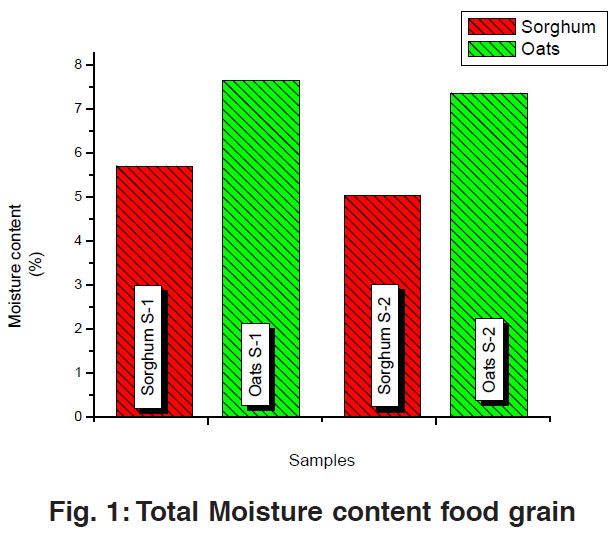 |
Figure 1: Total Moisture content food grain Click here to view figure |
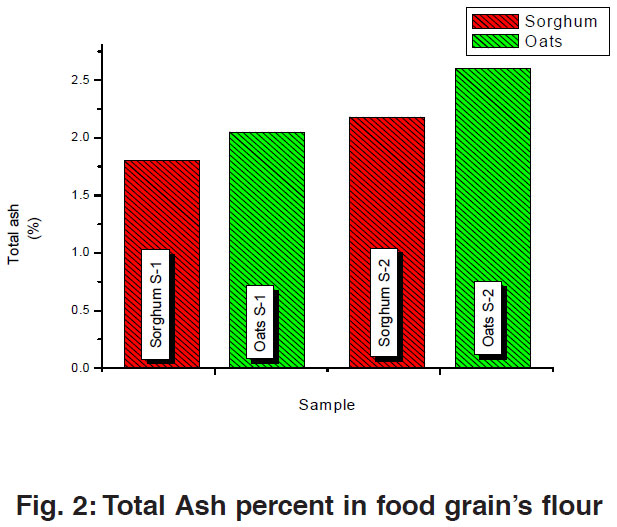 |
Figure 2: Total Ash percent in food grain’s flour Click here to view figure |
Results and Discussion
Present study revealed that the food grain thickness or firmness was found to vary significantly among the grain varieties, so it was decided to collect the sample only from the Bhopal city stake holder where the two most common varieties was available. The results obtained, give an idea of and similarity in the average grain size and are considered to be a function of kernel size and density (Douglas et al, 1998). While test weight determines the milling quality of all food grains and the kernel weight is decisively superior in predicting the milling quality of hard grain. Both test weight and kernel weight pronounce for the same quality character i.e. milling quality but their relationship has not been conclusively studied. A range of variability from 35.035 gm to 36.899 gm was observed for sorghum, where as the test weight or hectoliter weight varies between 69.210 to 77.110 and 57.113 to 62.320 for oats. Uneven spots or some times, the whole grains become whitish yellow because of the incidence of uneven distribution of the starch, which makes the grain unsuitable for making other products which has a negative effect on the quality and quantity of flour yield and yield stability and followed by lowers the protein content of the food grain. It is an important character which considered before scoring for food grain appearances. Such condition was often found specifically in the oats and the content of uneven starch having the yellow whitish spots was found to be higher in oats than that of the sorghum. The findings of this investigation suggest that wide variability exist in the food grain size among the different varieties of sorghum and oats which are in full support of the findings made by the scientists (Darwinkel et al., 1977; Randall and Moss, 1990; Gerry, and Wilson, 1995; Ghaffarzadeh, et al., 1994).
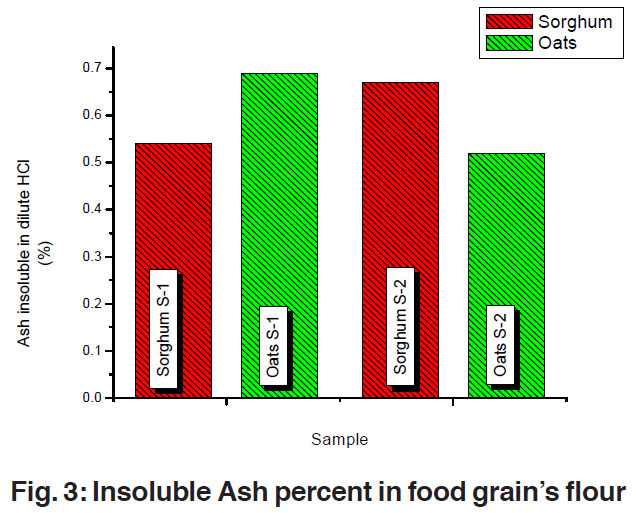 |
Figure 3: Insoluble Ash percent in food grain’s flour Click here to view figure |
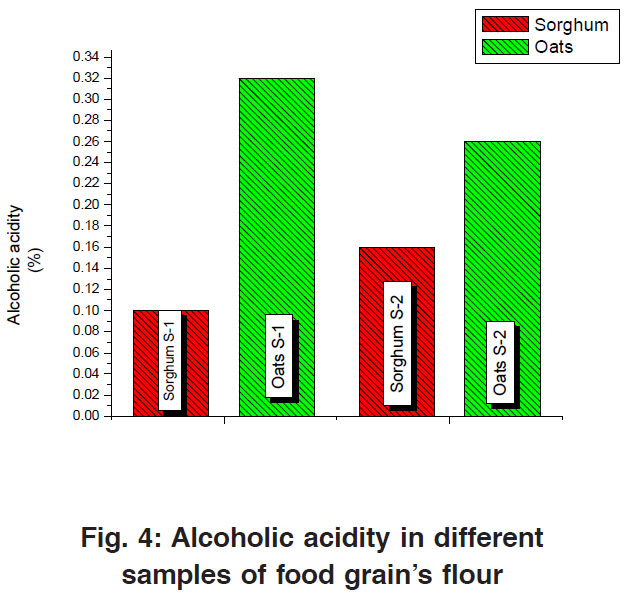 |
Figure 4: Alcoholic acidity in different samples of food grain’s flour Click here to view figure |
The results regarding the chemical parameters such as moisture content revealed that it ranged from 5.03% to 5.82 %and 7.66 %to 7.37%. Similarly, the total ash was found to be in a range of 1.80 %to 2.18% and 2.05% to 2.60 % for sorghum and oats respectively. Ash which was found insoluble in dilute hydrochloric acid was found with a range of 0.54 %and 0.64 %for sorghum, where as for oats it was in a range of 0.52%to 0.69 %. Alcoholic acidity was also determined for both selected samples and it was observed that the acidity was in a range of 0.10 %to 0.16%and 0.26% to 0.32% for sorghum and oats respectively. The wet gluten content indicated that this range sufficiently lower in comparison of other food grains sorghum which was found in a range of 3.0% to 3.5% but this value was found to be higher than the oats which showed its value in a range of 2.0% to 2.5 %. Study revealed that the fat content ranged from 3.60 to 4.01 and 2.38 %to 3.02 % in sorghum and oats respectively. Similarly the carbohydrate percentage found in a range of 65.52% to 69.60 % in the sorghum varieties showing a higher value where as the oats showed slightly lower value than that of sorghum with a range of 58.50% to 60.25% Fig. 1-7.
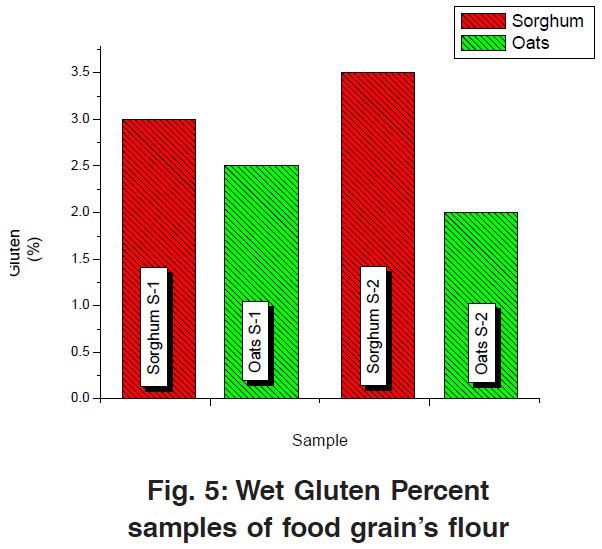 |
Figure 5: Wet Gluten Percent samples of food grain’s flour Click here to view figure |
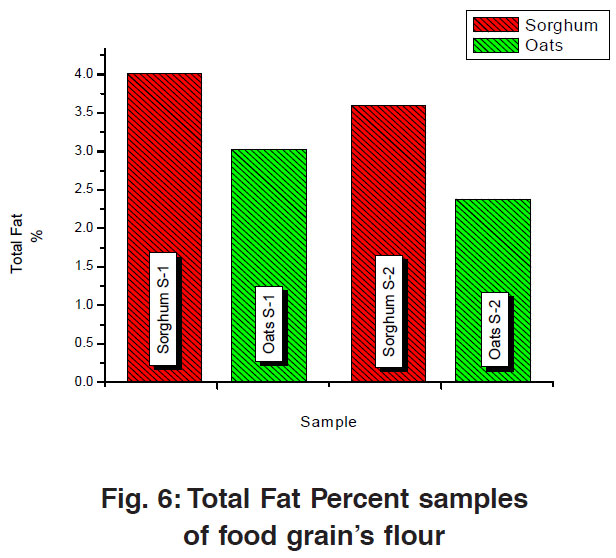 |
Figure 6: Total Fat Percent samples of food grain’s flour Click here to view figure |
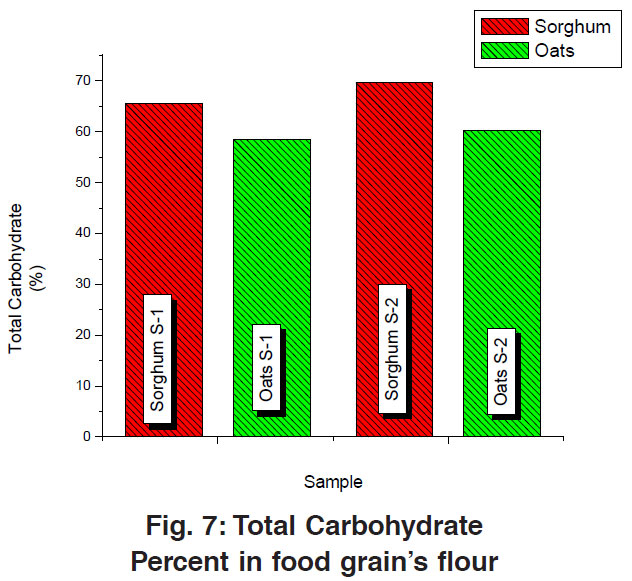 |
Figure 7: Total Carbohydrate Percent in food grain’s flour Click here to view figure |
The microbiology of food items such as sorghum and oats flour for total bacterial load and other fungal contamination as well as the studies of microbes present in the food grains has been done during the study period. The results revealed that the presence of bacterial and fungal load was not found beyond the limits and it was found within the permissible range (FAO/WHO1973). A significant data found during the study period that the microbial load was found in the lower and permissible limits in the oats in comparison of the value which was slight higher in sorghum samples. It may concluded from the study that the crop and food grains variety had the great influence on the Physico chemical, and nutritional characteristics for high yield and yield stability. Since the Food grains is composed of different chemical and biochemical components and each group is a complex mixture, these groups play a significant role in determining the quality of food grains its allied products and the present investigations is mainly concerned with the Physico-chemical profiling of food grains and allied products, the nutritional potential of the food grains with special reference to microbial load. The findings observed during the study period suggested the regular check up the quality of the farmer’s inputs and food grains quality assessment should be done regularly.
Acknowledgements
Thanks are due to Prof. Pramod K. Verma, Director General and Dr. S. Singh, Joint Director and In charge Quality Assurance Laboratory for extending support and constant encouragement. The authors are also thankful to all the staff of QAL offered selfless support and assistance to perform experimental work.
References
- A Report, on “Digestibility of Sorghum Proteins. Proceedings of National Academy of Sciences. USA. (2001) 78: 1333- 1335.
- AOAC 923.03 ICC No. 104/1, Method for the determination for cereals and cereal products 17th Ed. USA (1990).
- Doehlert, D.C., Mullen, M.S. and Riveland N.R., Sources of variation in kernel size in oats. Cereal Chem. (2002) 79: 528-534.
- FAO/WHO (Food and Agriculture Organization/World Health Organization)., “Energy and Protein Requirements” Report of a Joint FAO/WHO Ad Hoc Expert Committee. World Health Organization Technical Report, Series 522, Geneva (1973).
- Gerry, A.K., and S.D. Wilson., The influence of initial size on the competitive responses of six plant species. Ecology (1995) 76: 272-279.
- Ghaffarzadeh, M., F.G. Prechac, and R.M. Gruse., Grain yield response on corn, soybean and oat grown in a strip intercropping system. Am. J. Alternative Agric. (1994) 9: 171-177.
- Jambunathan R., Singh U., and Subramanian V., Grain quality of sorghum, pearl millet, pigeon-pea, and chick-pea, (1998) 52: 121-126.
- Darwinkel, A., B.A. Ten Haq and J. Kuizenga., Effect of sowing date and seed rate on crop development and grain production of winter wheat. Neth. J. Agric. Sci., (1977) 25: 83-84.
- Arain, M.A., Sial M.A. and Javed M.A., Stability analysis of wheat genotypes tested in multi- environmental trials (METs) in Sindh Province. Pak. J. Bot. 33: (special issue): (2001) 761-765.
- Chowdhry, S.I. and I.F. Wardlaw., The effect of temperature on kernel development in cereals. Aust. J. Agri. Res., (1978) 29: 205-223.
- Sial, M.A., M.A. Arain and M. Ahmad., Genotype x environment interaction on bread wheat grown over multiple sites and years in Pakistan. Pak. J. Bot., (2000) 32: 85-91.
- Sial, M.A., M.A. Arain, M.A. Javed and M.A. Rajput., Genotype-environment interaction for grain yield in bread wheat. Proceedings of Pakistan Academy of Plant Sciences, (2001) 38(1): 41-46.
- Fischer, R.A., Physiological limitations to producing wheat in semi-tropical and tropical environments and possible selection criteria. In: Wheats for More Tropical Environments. A Proceedings of the International Symposium, Mexico, D.F: CIMMYT, (1984) 209-230.
- Araus, J.L., J. Casadesus and J. Bort., Recent tools for the screening of physiological traits determining yield. In: Application of Physiology in Wheat Breeding. (Eds.): M.P. Reynolds, J.I. Ortiz Monasterio and A. Mc. Nab. Mexico, D.F.: CIMMYT, (2001) 59-77.
- Randall, P.J. and H.J. Moss., Some effects of temperature regime during grain filling on wheat quality. Aust. J. Agric. Res., (1990) 41: 603-617.
- Jambunathan, R., “Improvement of the Nutritional Quality of Sorghum and Pearl Millet.” Food and Nutrition Bulletin. The United Nations University, Tokyo, (1980) 2: 11-16.
- Douglas C. Doehlert, Michael S. McMullen, Jean-Luc Jannink, Surangan Panigrahi, Huanzhong Gu and Neil R. Riveland., Evaluation of Oat Kernel Size Uniformity, (1998) 5: 49-53.






